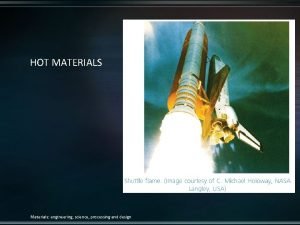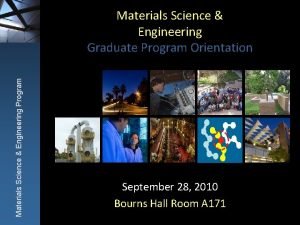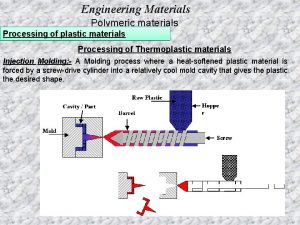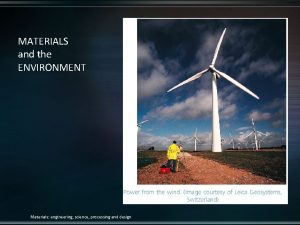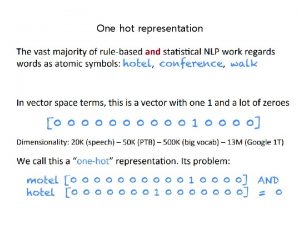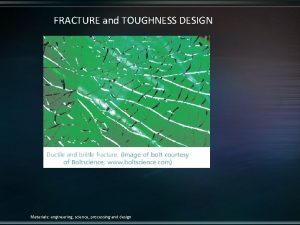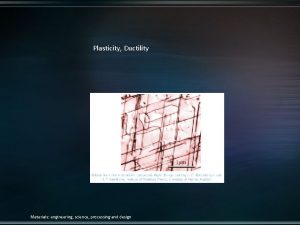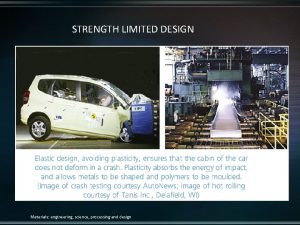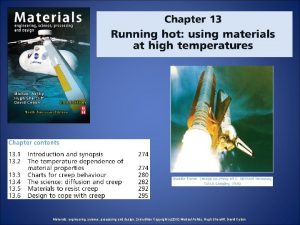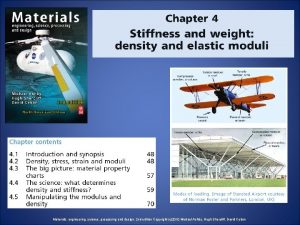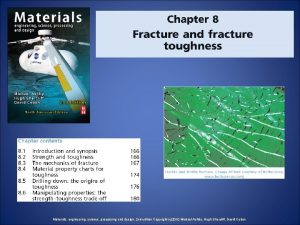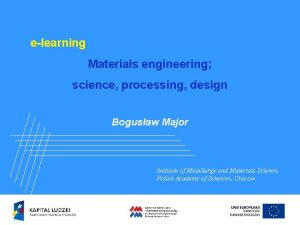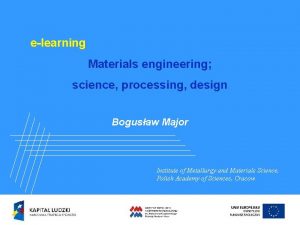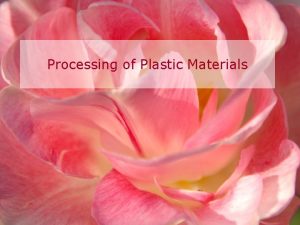HOT MATERIALS Materials engineering science processing and design

















- Slides: 17

HOT MATERIALS Materials: engineering, science, processing and design

Some material properties have a linear dependence on temperature while others may have an exponential relationship Materials: engineering, science, processing and design

Creep At room temperature, most metals and ceramics deform in way that depends on stress but no on time. As the temperature is raised, loads that are too small to give permanent deformation at room temperature cause materials to creep. Creep is slow, continuous deformation of a material at elevated temperatures, ending in fracture Materials: engineering, science, processing and design

Specimen is loaded in tension or compression, usually at a constant load, inside a furnace that is maintained at a constant temperature Materials: engineering, science, processing and design

Steady-state creep rate The constants ε 0, σo, n, and Qc are experimentally found and vary from material to material Materials: engineering, science, processing and design

Design data based on creep is generally presented in a stressrupture curve This allows you to identify either the design stress or rupture life at a given temperature Figure 13. 5 Materials: engineering, science, processing and design

The temperature at which a material starts to creep depends on its melting point Polymers can start to creep at room temperature Metals – 0. 35 Tm Ceramics – 0. 45 Tm Materials: engineering, science, processing and design

Figure 13. 7 Materials: engineering, science, processing and design

At room temperature, material selection requires only a singlestrength-density chart For high-temperature design, charts are needed that account for temperature and an acceptable strain rate Materials: engineering, science, processing and design

Diffusion is the spontaneous intermixing of atoms over time – the rate of diffusion is expressed by Fick’s law: D: diffusion constant dc/dx: concentration gradient In a crystalline solid, two things are needed for an atom to switch sites: 1)Enough thermal energy 2)An adjacent vacancy Figure 13. 9 Materials: engineering, science, processing and design

Figure 13. 11 The mean distance that one type of atom travels from diffusion is given by Materials: engineering, science, processing and design

Iron is hardened by introducing carbon through solid solution and precipitation strengthening Carburizing is a type of surface engineering technique in which carbon diffuses into the surface of a metal, locally increasing the concentration to that of a harder alloy Figure 13. 12 Materials: engineering, science, processing and design

Diffusion cause creep as well as fracture due to creep by creating voids that nucleate on grain boundaries Figure 13. 16 Materials: engineering, science, processing and design

Figure 13. 20 Materials: engineering, science, processing and design

Typical operating conditions of 650°C at 15 MPa Figure 13. 21 Design For a known design life, use the chart to find the stress below which fracture will not occur – then plug the stress value into the equation to find the minimum pipe thickness Figure 13. 22 Materials: engineering, science, processing and design

Figure 13. 23 At typical stress and temperature levels, pure nickel would deform by power-law creep at an unacceptable level The impact of strengthening mechanisms on MARM 200 nickel alloy reduces this rate by a factor of 106 Diffusional creep can then be slowed by increasing grain size Figure 13. 24 Materials: engineering, science, processing and design

SUMMARY All material properties depend on temperature Some are not very sensitive (density, modulus) Transport properties such as thermal conductivity are very sensitive Transport properties depend on diffusion Diffusion depends on vacancies and temperature Higher temperature-- higher rate of diffusion In diffusion, atoms move from place to place. It can occur in metals, ceramics, glasses, etc. - though details are different Diffusion is important in processing of materials Carburizing for example Diffusion is the source of creep and creep fracture Creep is the slow movement of materials over time Hot bolts need to be periodically tightened, etc. Materials: engineering, science, processing and design
 Materials: engineering, science, processing and design
Materials: engineering, science, processing and design Iit delhi eacademics
Iit delhi eacademics My favorite subject is math
My favorite subject is math White hot vs red hot temperature
White hot vs red hot temperature Hot working metal
Hot working metal Perbedaan hot lava dan hot lava volcano
Perbedaan hot lava dan hot lava volcano Be either hot or cold
Be either hot or cold Neighborhood averaging in image processing
Neighborhood averaging in image processing What is secondary food processing
What is secondary food processing Batch processing vs interactive processing
Batch processing vs interactive processing Top down vs bottom up processing
Top down vs bottom up processing Bottom up processing vs top down processing
Bottom up processing vs top down processing Bottom-up processing examples
Bottom-up processing examples Fractal
Fractal Histogram processing in digital image processing
Histogram processing in digital image processing Parallel processing vs concurrent processing
Parallel processing vs concurrent processing A generalization of unsharp masking is
A generalization of unsharp masking is What is point processing in digital image processing
What is point processing in digital image processing
